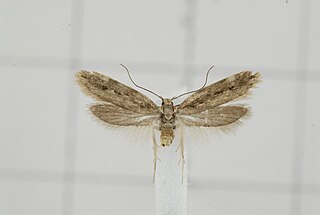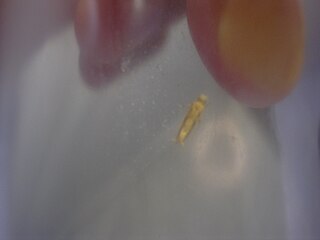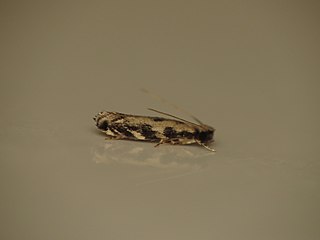
Ethmiopsis is a genus of the twirler moth family (Gelechiidae). Among these, it was previously assigned to subfamily Pexicopiinae, but later moved to the Chelariini tribe.
Chrysophyllis is a genus of the grass moth family (Crambidae). It is monotypic, containing the single species Chrysophyllis lucivaga. This moth is very little known, having only been recorded once, before 1935. It belongs to the large grass moth subfamily Spilomelinae; at the time of its description, these were still included in subfamily Pyraustinae and the entire Crambidae was then merged with the snout moths. While its exact relationships are undetermined, it is believed to be a close relative of Talanga. Like these, the male genitalia of C. lucivaga feature a remarkably elongated aedeagus shaped like a bullwhip.

Eudonia is a large and widespread genus in the grass moth family (Crambidae), subfamily Scopariinae. There is no common name for the roughly 250 species placed here; new species are still being described regularly. Although the genus was proposed early in the 19th century, many of these moths were for a long time retained in Scoparia, the type genus of the subfamily and a close relative of Eudonia. A few small genera have been proposed for separation from Eudonia, but given the size of this group this is not particularly convincing; thus, all are retained here pending a comprehensive phylogenetic review.
Marasmianympha is a genus of moths of the grass moth family (Crambidae) described by Eugene G. Munroe in 1991. Its single species, Marasmianympha eupselias, was described by Edward Meyrick in 1929. Among the grass moths, it belongs to subfamily Spilomelinae. It is endemic to the Marquesas Islands of Polynesia, where it has been recorded on Fatu Hiva, Hiva Oa and Tahuata, but is suspected to occur on other islands as well. The holotype specimen is in the Natural History Museum, London.
Tessema sensilis is a little-known moth species, the only member of genus Tessema. It belongs to the grass moth family (Crambidae), and therein to the large subfamily Spilomelinae; at the time of its description, these were still included in subfamily Pyraustinae and the entire Crambidae was then merged with the snout moths. While its detailed relationships are undetermined, it may be a close relative of Herpetogramma and/or Pilocrocis.
Clarkeophlebia is an enigmatic and almost-unknown gelechioid moth genus. It contains a single species, Clarkeophlebia argentea, and is apparently endemic to Fatu Hiva in the Marquesas Islands of Polynesia. It was originally described as Acanthophlebia, but this name had earlier been given to a genus of prong-gilled mayflies.
Herlinda is a genus of cosmet moths. These moths were only discovered in 1968 and the genus was not described until 1986; its affiliations within the family are presently unknown. This genus, as far as is known, is endemic to the Marquesas Islands of Polynesia, with each species confined to a single island.
Comodica is a small genus of the fungus moth family, Tineidae. Therein, it belongs to the subfamily Erechthiinae. It is apparently a close relative of the type genus of its subfamily, Erechthias.

Erechthias is a genus of the fungus moth family, Tineidae. Therein, it belongs to the subfamily Erechthiinae, of which it is the type genus. The exact circumscription of this genus is still disputed, but it may encompass more than 150 species.

Anatrachyntis rileyi, the pink cornworm, pink bud moth or pink scavenger, is a species of moth of the family Cosmopterigidae, the cosmet moths. It was first described by Lord Walsingham in 1882 from the southern United States, but it is probably an introduction to North America. It is found in much of the warm or tropical areas of the world, including northern Australia, the Galápagos Islands, Hawaii, the Antilles, South America and Mauritius.
Phereoeca allutella, the household case-bearing moth, belongs to the subfamily Tineinae of the fungus moth family (Tineidae). It was first described by Hans Rebel in 1892. It is an occasional pest of furs, flannel and similar materials, and has been inadvertently introduced to many places it is not originally native to.
Erechthias flavistriata, the sugarcane bud moth, is a moth of the family Tineidae. It was described by Lord Walsingham in 1907 from Hawaii, but is probably an introduced species. It is found in large parts of the Pacific Rim including the Marquesas, Rapa Iti, Fiji, the New Hebrides, the Kermadec Islands, the Solomons, Java and Malaya. It has been spread widely by man and probably has travelled to many islands throughout much of the Pacific in the canoes of the native peoples.

Erechthias minuscula, the erechthias clothes moth, is a moth of the family Tineidae. It was first described by Lord Walsingham in 1897. It is widespread and has been recorded from Africa, Sri Lanka, Java, Australia, the Caroline Islands, Fiji, Samoa, the Marquesas, the West Indies, Hawaii and Florida.

Erechthias zebrina is a fungus moth. Initially, it was mistakenly believed to be an ermine moth of genus Argyresthia.
Mecomodica fullawayi is a fungus moth of the subfamily Erechthiinae. It was first described by Otto Swezey in 1926.

Stoeberhinus testaceus, the potato moth, is a gelechioid moth, supposedly the only species of its genus Stoeberhinus. However, the genus might also include some related moths presently placed in Autosticha. It belongs to the subfamily Autostichinae, which is either placed in the concealer moth family (Oecophoridae), or in an expanded Autostichidae.

Diaphania indica, the cucumber moth or cotton caterpillar, is a widespread but mainly Old World moth species. It belongs to the grass moth family, and therein to the large subfamily Spilomelinae. This moth occurs in many tropical and subtropical regions outside the Americas, though it is native to southern Asia; it is occasionally a significant pest of cucurbits and some other plants.
Epicephala spinula is a moth of the family Gracillariidae, one of the most primitive groups of ditrysian "micromoths". Within its family, it belongs to the subfamily Gracillariinae. Even though it was first scientifically studied in 1929, for many decades the specimens of this moth were mistaken for the related Australian species E. colymbetella, and their distinctness was only realized in 1986. It is found on the Marquesas Islands, where it occurs at least on Nuku Hiva, Ua Pou, and Fatu Hiva, and though little-known it is apparently not uncommon. The holotype specimen, a female, is USNM 100839.
Caloptilia insidia is a moth of the family Gracillariidae, one of the most primitive groups of ditrysian "micromoths". Within its family, it belongs to the subfamily Gracillariinae. It is apparently endemic to Fatu Hiva and Hiva Oa in the Marquesas Islands, French Polynesia. It is very similar to C. deltanthes. The species does not seem to be common, and no females appear to have been encountered yet.
Ernophthora is a genus of small moths belonging to the snout moth family (Pyralidae). They form part of the Cabniini, a rather small tribe of the huge snout moth subfamily Phycitinae. This genus is generally found in the Australia-Pacific region.








